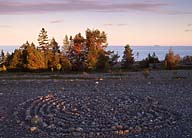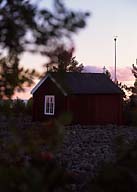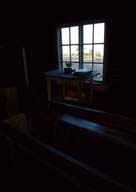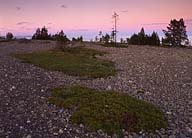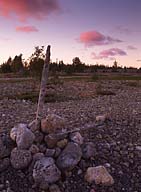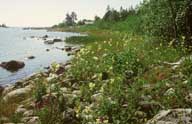Snöan archipelago
Snöan is the main island in an archipelago of small
islands and islets, which slowly rise from the sea outside the
Järnäs peninsula and Hörnefors. Snöan, which
is the biggest and highest of the islands, rose from the sea at
about 2000 years ago as a solitary reef far out to sea. Five hundred
years later the eastern part of the island, now known as Österskatan,
was used by fishermen and seal hunters of the time. A hike over
Österskatan's heaths reveals traces of these ancestors in
the form of several house foundations or tomtningar in the rock
rubble fields. These tomtningar are circular stone walls which
surrounded the simple dwellings. When the western portion of Snöan,
Västerskatan, rose from the sea, the island's hunters and
fishermen built a sheltered harbour inside the bay between the
two sides of the island. Look at the dip between Österskatan
and Västerskatan to see traces of the old harbour in an elongated
bog with foundations from sheds and dock attachments and a maze
on the sides.
In the sixteenth century Österskatan once again had
a harbour and it was during this time that all of Snöan's
mazes and compass roses were arranged in the rock rubble fields.
In the nineteenth century a small chapel was built on
the southern portion of Österskatan. Until the 1940s fishermen
kept goats and cows on Snöan, which is one of the reasons
that the island landscape is still so open, characterised by its
heaths. A clear cultural influence on the vegetation can be seen
in particular between the old chapel and the shore. Slowly but
surely, however, young pine forests are becoming established on
the island. A closed stand of pines can already be found in the
dip between Österskatan and Västerskatan. Out on the
heaths, spruce grow in groups known as "grankloner"
which are also slowly growing together to form continuous stands
of trees.
Snöan's beaches feature both sea buckthorn shrubs
and richly blooming shoreline meadows. The large archipelago has
an abundance of birdlife with species such as the black guillemot
(Cepphus grylle), red-breasted merganser
(Mergus serrator), goosander (Mergus
merganser), velvet scoter (Melanitta
fusca), common eider (Somateria mollissima),
greater scaup (Aythya marila), skua (Stercorarius
parasiticus) and turnstone (Arenaria
interpres).
The entire archipelago is protected as a nature reserve.
Going ashore is prohibited on the islands of Måkläppen,
Gråskär and Pilhällrevet between 15 April and
15 August to protect birdlife.
Snöan is classified as a historic environment of
national interest.
| 
